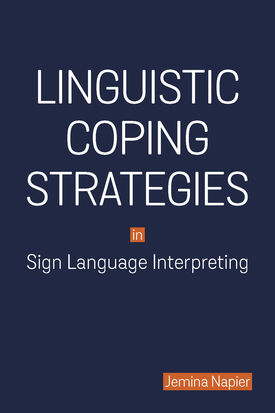
Linguistic Coping Strategies in Sign Language Interpreting
This ground-breaking work, originally published 15 years ago, continues to serve as the primary reference on the theories of omission potential and translational contact in sign language interpreting. Noted scholar Jemina Napier explores the linguistic coping strategies of interpreters by drawing on her own study of the interpretation of a university lecture from English into Australian Sign Language (Auslan). A new preface by the author provides perspective on the importance of the work and how it fits within the scholarship of interpretation studies.
Description
This ground-breaking work, originally published 15 years ago, continues to serve as the primary reference on the theories of omission potential and translational contact in sign language interpreting. In the book, noted scholar Jemina Napier explores the linguistic coping strategies of interpreters by drawing on her own study of the interpretation of a university lecture from English into Australian Sign Language (Auslan). A new preface by the author provides perspective on the importance of the work and how it fits within the scholarship of interpretation studies.
The concept of strategic omissions is explored here as a tool that is consciously used by interpreters as a coping strategy. Instead of being a mistake, omitting part of the source language can actually be part of an active decision-making process that allows the interpreter to convey the correct meaning when faced with challenges. For the first time, Napier found that omission potential existed within every interpretation and, furthermore, she proposed a new taxonomy of five different conscious and unconscious omission types. Her findings also indicate that Auslan/English interpreters use both a free and literal interpretation approach, but that those who use a free approach occasionally switch to a literal approach as a linguistic coping strategy to provide access to English terminology. Both coping strategies help negotiate the demands of interpretation, whether it be lack of subject-matter expertise, dealing with dense material, or the context of the situation.
Napier also analyzes the interpreters’ reflections on their decision-making processes as well as the university students’ perceptions and preferences of their interpreters’ linguistic choices and styles. Linguistic Coping Strategies in Sign Language Interpreting is a foundational text in interpretation studies that can be applied to interpreting in different contexts and to interpreter training.
Jemina Napier is a professor and chair of Intercultural Communication in the Department of Languages and Intercultural Studies at Heriot-Watt University in Edinburgh, Scotland.
Reviews
Linguistic Coping Strategies in Sign Language Interpreting is generally an accessible read, and the second edition provides a valuable resource to student and novice interpreters. It is particularly useful for signed language interpreters as they reflect on their work in higher education. Interpreter trainers can use the book in several ways.
— International Journal of Interpreter Education